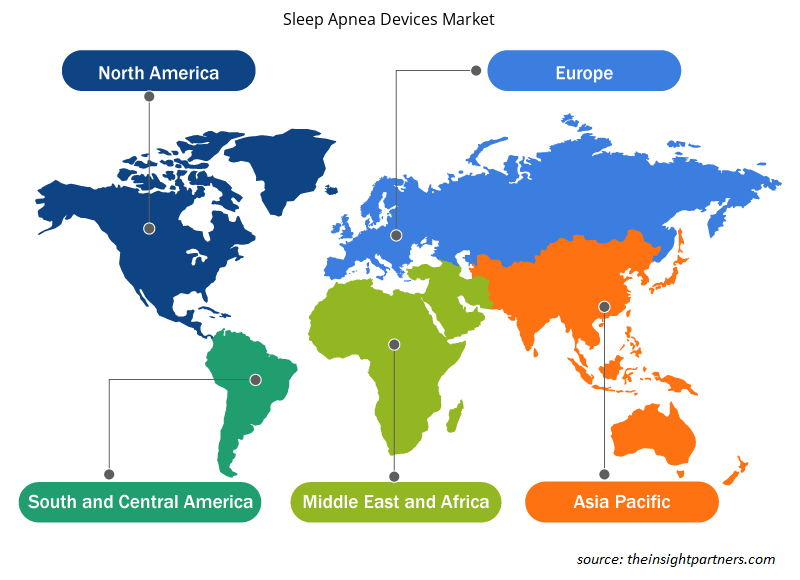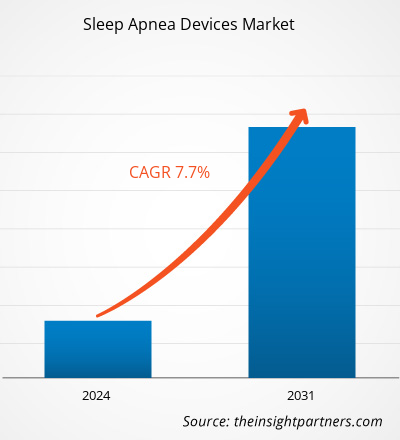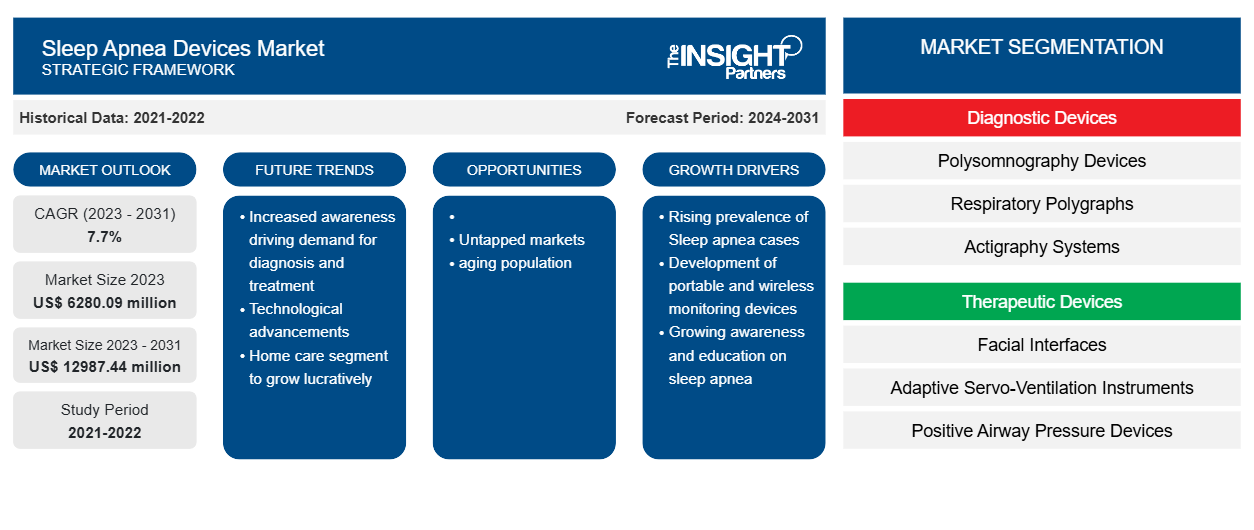El tamaño del mercado de dispositivos para la apnea del sueño se estimó en US$ 6280,09 millones en 2023 y se espera que alcance los US$ 12 987,44 millones para 2031; se estima que registrará una CAGR del 7,7% en 2031. Es probable que la creciente prevalencia de enfermedades respiratorias, el estilo de vida sedentario, el aumento del envejecimiento de la población (mayores de 60 años) y la creciente prevalencia de trastornos crónicos sigan siendo tendencias clave del mercado de dispositivos para la apnea del sueño.
Análisis del mercado de dispositivos para la apnea del sueño
Es probable que el aumento de la esperanza de vida en todo el mundo aumente la prevalencia de los trastornos del sueño. El estudio 'Global Prevalence of Obstructive Sleep Apnea in the Elderly and Related Factors: A Systematic Review and Meta-Analysis Study', publicado en junio de 2023, tuvo como objetivo combinar datos y estadísticas sobre la prevalencia mundial de OSA en la población de edad avanzada. Combinó datos de 39 estudios con un tamaño de muestra total de 33.353 personas. La prevalencia agrupada de OSA en la población de edad avanzada fue del 35,9% (intervalo de confianza del 95%: 28,7%-43,8%; I2 = 98,81%). Se prevé que el factor mencionado anteriormente tenga un impacto positivo en el crecimiento del mercado de dispositivos para la apnea del sueño.
Descripción general del mercado de dispositivos para la apnea del sueño
El crecimiento del mercado de dispositivos para la apnea del sueño se atribuye a algunos factores impulsores clave, como la creciente prevalencia de enfermedades respiratorias, el estilo de vida sedentario, el aumento del envejecimiento de la población (mayores de 60 años) y la creciente prevalencia de trastornos crónicos. Sin embargo, las mascarillas con fugas y los problemas para conciliar el sueño son factores importantes que obstaculizan el crecimiento del mercado. El mercado mundial de dispositivos para la apnea del sueño está segmentado por región en América del Norte, Europa, Asia Pacífico, Oriente Medio y África, y América del Sur y Central. En América del Norte, Estados Unidos es el mercado más grande de dispositivos para la apnea del sueño. El crecimiento de la región se atribuye a la presencia de actores clave del mercado y a la creciente prevalencia de la población geriátrica. Además, se espera que los continuos desarrollos de productos estimulen aún más el crecimiento del mercado de dispositivos para la apnea del sueño en América del Norte.
Se espera que la región de Asia Pacífico sea la que registre el crecimiento más rápido en el mercado de dispositivos para la apnea del sueño. Es probable que el mercado de dispositivos para la apnea del sueño en Asia Pacífico experimente un rápido crecimiento debido a una gran población, el aumento del turismo médico y la disponibilidad de dispositivos para la apnea del sueño rentables. Se espera que este factor ayude al crecimiento del mercado de dispositivos para la apnea del sueño durante el período de pronóstico.
Personalice este informe según sus necesidades
Obtendrá personalización en cualquier informe, sin cargo, incluidas partes de este informe o análisis a nivel de país, paquete de datos de Excel, así como también grandes ofertas y descuentos para empresas emergentes y universidades.
-
Obtenga las principales tendencias clave del mercado de este informe.Esta muestra GRATUITA incluirá análisis de datos, desde tendencias del mercado hasta estimaciones y pronósticos.
Impulsores y oportunidades del mercado de dispositivos para la apnea del sueñoApnea Devices Market Drivers and Opportunities
La creciente prevalencia de enfermedades cardiovasculares favorece el mercado
La enfermedad cardiovascular se refiere a las siguientes 4 entidades, es decir, enfermedad de la arteria coronaria (CAD), que también se conoce como enfermedad cardíaca coronaria (CHD), enfermedad cerebrovascular, enfermedad arterial periférica (PAD) y aterosclerosis aórtica. Según el Instituto Nacional de Salud (NIH), se estima que 16,3 millones de estadounidenses de 20 años o más tienen CHD, una prevalencia del 7 por ciento. La prevalencia para los hombres es del 8,3 por ciento y para las mujeres es del 6,1 por ciento. La PAP continua (CPAP) es el tratamiento común para pacientes con AOS moderada a severa (IAH ≥ 15 eventos / h) en ausencia de síntomas, pero también se recomienda para el tratamiento de pacientes con AOS leve (IAH 5-15 eventos / h) en presencia de EDS u otras comorbilidades como obesidad, hipertensión y paro cardíaco. Es probable que esta necesidad impulse el mercado de dispositivos para la apnea del sueño durante el período de pronóstico.i.e., coronary artery disease (CAD) which is also referred to as coronary heart disease (CHD), cerebrovascular disease, peripheral artery disease (PAD), and aortic atherosclerosis. According to the National Institute of Health (NIH), an estimated 16.3 million Americans aged 20 and older have CHD, a prevalence of 7 percent. The prevalence for men is 8.3 percent and for women is 6.1 percent. Continuous PAP (CPAP) is the common treatment for patients with moderate to severe OSA (AHI ≥ 15 events/h) in the absence of symptoms, but it is also recommended for the treatment of mild OSA patients (AHI 5-15 events/h) in the presence of EDS or other comorbidities such as obesity, hypertension, and cardiac arrest. This need is likely to drive the sleep apnea devices market during the forecast period.
Desarrollos tecnológicos: una oportunidad en el mercado de dispositivos para la apnea del sueñoApnea Devices Market
La apnea obstructiva del sueño (AOS) es un trastorno normal y muy común que se caracteriza por el cierre repetitivo, completo o parcial de las vías respiratorias superiores. Por el contrario, el sueño es útil para la fragmentación del sueño y la desaturación de oxígeno. El trastorno causa una morbilidad significativa, especialmente en términos de deterioro del funcionamiento diurno y el impacto que esto tiene en la calidad de vida. La indicación reciente de los ensayos controlados es una prueba de que la terapia con dispositivos bucales es muy eficaz para controlar la AOS en hasta el 50,0% de los pacientes, incluidos algunos pacientes con formas más graves de AOS. Esto se asocia con una mejora significativa de los síntomas, incluidos los ronquidos y la somnolencia diurna. Esta evidencia es sólida para el tratamiento a corto plazo y el emergente tratamiento a largo plazo de la AOS con dispositivos bucales. Varias empresas han desarrollado sus productos para tratar la apnea del sueño y los accesorios relacionados. Por ejemplo, los dispositivos SomnoDent desarrollados por SomnoMed Limited han aumentado en el año anterior, 2016, del 68% al 68,6%, lo que significa que los productos han alcanzado la línea de productos de firma. Además, SomnoDent Alpha se desarrolló y recibió la aprobación de la FDA en septiembre de 2016. Alpha es un dispositivo de ajuste instantáneo que se utiliza en clínicas del sueño para ofrecer al paciente y entregar datos de eficacia de un tratamiento de terapia continua de las vías respiratorias abiertas (COAT) relacionado con un paciente específico antes de que se fabrique un dispositivo a medida para el paciente. En febrero de 2024, ResMed lanzó su serie AirCurve 11, que son dispositivos de dos niveles que utilizan dos niveles de soporte, presión positiva inspiratoria en las vías respiratorias (IPAP) y presión positiva espiratoria en las vías respiratorias (EPAP). La serie AirCurve 11 se combina con tecnología digital para ayudar a tratar la apnea del sueño. Se estima que estos avances tecnológicos generarán una oportunidad de crecimiento atractiva para el mercado de dispositivos para la apnea del sueño.apnea (OSA) is a normal and very common disorder categorized by the upper airway's repetitive, complete, or partial closure. In contrast, sleep is helpful in the fragmentation of sleep and oxygen desaturation. The disorder causes significant morbidity, especially in terms of impairment of daytime functioning and the impact this has on quality of life. The recent indication from the controlled trials is proof that oral appliance therapy is very effective in controlling OSA in up to 50.0% of patients, including some patients with more severe forms of OSA. This is associated with a significant improvement in symptoms, including snoring and daytime sleepiness. This evidence is strong for short-term and emerging long-term treatment of OSA with oral appliances. Various companies have developed their products for treating sleep apnea and related accessories. For instance, SomnoDent devices developed by SomnoMed Limited have increased in the previous year, 2016, from 68% to 68.6%, which signifies that the products have achieved the signature line of products. Additionally, SomnoDent Alpha has developed and received FDA approval in September 2016. The Alpha is an instant fit device used in sleep clinics for offering the patient and delivering efficacy data of a continuous open airway ResMed launched its AirCurve 11 series which are the bilevel devices that use two levels of support, inspiratory positive airway pressure (IPAP) and expiratory positive airway pressure (EPAP). The AirCurve 11 series is combined with digital tech to help treat sleep apnea. Such technological advancements are estimated to generate attractive growth opportunity for the sleep apnea devices market.
Análisis de segmentación del informe de mercado de dispositivos para la apnea del sueño
Los segmentos clave que contribuyeron a la derivación del análisis del mercado de dispositivos para la apnea del sueño son los dispositivos de diagnóstico y el usuario final.
- En cuanto a los dispositivos de diagnóstico, el mercado de dispositivos de diagnóstico de la apnea del sueño se segmenta en dispositivos de polisomnografía, polígrafos respiratorios, sistemas de actigrafía y oxímetros. El mercado de la apnea del sueño está impulsado principalmente por los dispositivos de polisomnografía, ya que son dispositivos más avanzados y especializados que otros.
- El mercado mundial de la apnea del sueño, basado en el usuario final, se segmentó en atención médica domiciliaria y laboratorios y hospitales del sueño. En 2023, el segmento de atención médica domiciliaria tuvo la mayor participación del mercado por usuario final. Además, también se espera que el segmento crezca al ritmo más rápido durante los próximos años debido a las ventajas de los segmentos de atención médica domiciliaria. Los servicios de atención médica domiciliaria son similares a los centros de enfermería especializada y los hospitales disponibles para tratar a los pacientes en casa. Estas instalaciones se utilizan para tratar lesiones y enfermedades con más comodidad y menos costo. Este servicio ayuda a los pacientes a tratar sus enfermedades y lesiones y los ayuda a ser autosuficientes para recuperar su independencia. Los pacientes se sienten más cómodos y relajados en sus propias casas y responden bien al tratamiento.apnea market, based on the end-user, was segmented into home healthcare, and sleep laboratories & hospitals. In 2023, the home healthcare segment held the largest share of the market by end user. In addition, the segment is also expected to grow at the fastest rate during the coming years owing to the advantages of the home healthcare segments. Home healthcare services are similar to skilled nursing facilities and hospitals available to treat patients at home. These facilities are used to treat injuries and diseases with more convenience and less cost. This service helps patients treat their sicknesses and injuries and helps them be self-sufficient to regain their independence. The patients feel more comfortable and relaxed in their own houses and respond well to the treatment.
Análisis de la cuota de mercado de los dispositivos para la apnea del sueño por geografíaApnea Devices Market Share Analysis by Geography
El alcance geográfico del informe del mercado de dispositivos para la apnea del sueño se divide principalmente en cinco regiones: América del Norte, Asia Pacífico, Europa, Medio Oriente y África, y América del Sur/América del Sur y Central.Apnea Devices Market report is mainly divided into five regions: North America, Asia Pacific, Europe, the Middle East & Africa, and South America/South & Central America.
En términos de ingresos, América del Norte dominó la participación de mercado de dispositivos para la apnea del sueño. El mercado de dispositivos para la apnea del sueño de América del Norte se ha segmentado en Estados Unidos, Canadá y México. Estados Unidos tiene la mayor participación en el mercado de dispositivos para la apnea del sueño de América del Norte. La creciente prevalencia de los trastornos de la apnea del sueño entre la población estadounidense es uno de los factores clave que aumentan la demanda de dispositivos para la apnea del sueño, impulsando así el crecimiento del mercado de América del Norte. Además, es probable que la alta prevalencia de la apnea del sueño y la creciente conciencia sobre los trastornos del sueño y sus factores de riesgo en los EE. UU. impulsen el mercado de dispositivos para la apnea del sueño de EE. UU. Según los Centros para el Control y la Prevención de Enfermedades (CDC), alrededor de un tercio de la población de EE. UU. duerme menos de la cantidad necesaria. Además, según la Asociación Estadounidense de Apnea del Sueño, alrededor de 22 millones de estadounidenses padecen apnea del sueño. Por lo tanto, la creciente prevalencia de la apnea del sueño probablemente contribuirá al crecimiento del tamaño del mercado de dispositivos para la apnea del sueño de EE. UU.
Perspectivas regionales del mercado de dispositivos para la apnea del sueño
Los analistas de Insight Partners explicaron en detalle las tendencias y los factores regionales que influyen en el mercado de dispositivos para la apnea del sueño durante el período de pronóstico. Esta sección también analiza los segmentos y la geografía del mercado de dispositivos para la apnea del sueño en América del Norte, Europa, Asia Pacífico, Oriente Medio y África, y América del Sur y Central.

- Obtenga datos regionales específicos para el mercado de dispositivos para la apnea del sueño
Alcance del informe de mercado de dispositivos para la apnea del sueño
| Atributo del informe | Detalles |
|---|---|
| Tamaño del mercado en 2023 | US$ 6280,09 millones |
| Tamaño del mercado en 2031 | US$ 12.987,44 millones |
| CAGR global (2023 - 2031) | 7,7% |
| Datos históricos | 2021-2022 |
| Período de pronóstico | 2024-2031 |
| Segmentos cubiertos |
Por dispositivos de diagnóstico
|
| Regiones y países cubiertos |
América del norte
|
| Líderes del mercado y perfiles de empresas clave |
|
Densidad de actores del mercado: comprensión de su impacto en la dinámica empresarial
El mercado de dispositivos para la apnea del sueño está creciendo rápidamente, impulsado por la creciente demanda de los usuarios finales debido a factores como la evolución de las preferencias de los consumidores, los avances tecnológicos y una mayor conciencia de los beneficios del producto. A medida que aumenta la demanda, las empresas amplían sus ofertas, innovan para satisfacer las necesidades de los consumidores y aprovechan las tendencias emergentes, lo que impulsa aún más el crecimiento del mercado.
La densidad de actores del mercado se refiere a la distribución de las empresas o firmas que operan dentro de un mercado o industria en particular. Indica cuántos competidores (actores del mercado) están presentes en un espacio de mercado determinado en relación con su tamaño o valor total de mercado.
Las principales empresas que operan en el mercado de dispositivos para la apnea del sueño son:
- Resmed
- Philips NV, la línea Koninklijke
- Pescador y Paykel
- Corporación Médica Braebon
- Compumedics Limitada
- BMC Medical Co., Ltd
Descargo de responsabilidad : Las empresas enumeradas anteriormente no están clasificadas en ningún orden particular.

- Obtenga una descripción general de los principales actores clave del mercado de dispositivos para la apnea del sueño
Noticias y desarrollos recientes del mercado de dispositivos para la apnea del sueño
El mercado de dispositivos para la apnea del sueño se evalúa mediante la recopilación de datos cualitativos y cuantitativos posteriores a la investigación primaria y secundaria, que incluye publicaciones corporativas importantes, datos de asociaciones y bases de datos. A continuación, se incluye una lista de los avances en el mercado de dispositivos para la apnea del sueño y las estrategias:
- Evora Full: una máscara facial compacta para la apnea del sueño que cuenta con un sello flotante y alas de estabilidad que funcionan juntas para crear la próxima generación de tecnología de soporte dinámico. El sello compacto flota debajo de la nariz para brindarles a los pacientes una línea de visión clara, mientras que las alas de estabilidad mantienen el sello estable. (Fuente: Fisher & Paykel Healthcare, Corporate News, 2022)
Informe sobre el mercado de dispositivos para la apnea del sueño: cobertura y resultados
El informe “Tamaño y pronóstico del mercado de dispositivos para la apnea del sueño (2021-2031)” proporciona un análisis detallado del mercado que cubre las siguientes áreas:
- Tamaño del mercado y pronóstico a nivel global, regional y nacional para todos los segmentos clave del mercado cubiertos bajo el alcance
- Dinámica del mercado, como impulsores, restricciones y oportunidades clave
- Principales tendencias futuras
- Análisis detallado de las cinco fuerzas de Porter y PEST y FODA
- Análisis del mercado global y regional que cubre las tendencias clave del mercado, los principales actores, las regulaciones y los desarrollos recientes del mercado.
- Análisis del panorama de la industria y de la competencia que abarca la concentración del mercado, el análisis de mapas de calor, los actores destacados y los desarrollos recientes
- Perfiles detallados de empresas
- Análisis histórico (2 años), año base, pronóstico (7 años) con CAGR
- Análisis PEST y FODA
- Tamaño del mercado, valor/volumen: global, regional y nacional
- Industria y panorama competitivo
- Conjunto de datos de Excel
Informes recientes
Testimonios
Razón para comprar
- Toma de decisiones informada
- Comprensión de la dinámica del mercado
- Análisis competitivo
- Información sobre clientes
- Pronósticos del mercado
- Mitigación de riesgos
- Planificación estratégica
- Justificación de la inversión
- Identificación de mercados emergentes
- Mejora de las estrategias de marketing
- Impulso de la eficiencia operativa
- Alineación con las tendencias regulatorias























 Obtenga una muestra gratuita para - Mercado de dispositivos para la apnea del sueño
Obtenga una muestra gratuita para - Mercado de dispositivos para la apnea del sueño